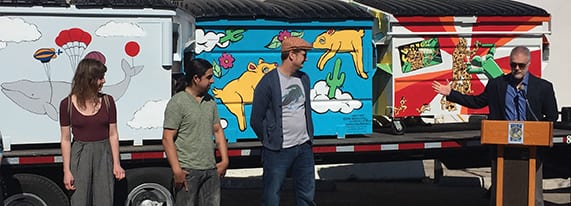On February 5, members of the Graffiti Resource Council® (GRC®) participated in the official unveiling of the City of Tucson’s mural project, for which GRC provided a $5,000 grant to reduce graffiti. Last fall, GRC’s grant to the Tucson Arts Brigade (TAB) was matched by the City of Tucson’s Environmental Services, which funded the painting of murals on five metal city dumpsters. Five Tucson artists designed and painted the murals on the waste containers to be provided to businesses in areas that have a high potential for tagging.
GRC hopes that the murals will help deter graffiti vandalism, and help beautify the city. The project has received strong support from Tucson Mayor Jonathan Rothschild, City Councilman Steve Kozachik, and City Councilman Karin Uhlich.
“We know that many cities in Arizona, and Tucson in particular, have dealt with graffiti vandalism for a long time, and that graffiti is a serious issue,” said Javaneh Nekoomaram, GRC’s advocacy counsel, speaking at the event. “It promotes crime, devalues property, slows economic growth and tourism, and damages the aesthetic value of a community. It is a problem that, if not addressed early on, will spread and multiply, causing larger issues down the line. We are proud to have embarked on this project with Tucson because we know that this is a city that is dedicating to solving the graffiti problem.”
GRC is a nonprofit corporation whose primary goal is to prevent graffiti vandalism and provide creative solutions that promote graffiti-free communities. GRC provides information, education, and legislative assistance to help communities develop effective policies and comprehensive programs that prevent graffiti vandalism. To fulfill its purpose, the council conducts research; gathers and evaluates information; develops comprehensive strategies, policies, and programs; and provides implementation assistance designed to eliminate graffiti vandalism and promote positive, innovative anti-graffiti strategies for communities. GRC is funded by the aerosol coatings industry concerned about the negative impact of graffiti vandalism on America’s communities.
GRC has been active in its advocacy and providing assistance and guidance to cities faced with graffiti vandalism. With the success of the Tucson project, it will offer more grants to municipalities that want to partner to fight graffiti vandalism.
In Tucson, the murals will also supplement the city’s comprehensive efforts to combat vandalism, which include other murals painted on libraries, overpasses, and public areas throughout the city—an aggressive abatement program through a partnership with Graffiti Protective Coatings, educational projects for youths such as a poster contest, and penalties for graffiti vandals.
Gregory L. Johnson, director of federal affairs for The Sherwin-Williams Company and chair of GRC’s board of directors, also addressed attendees at the unveiling. Support and generous funding from GRC members, including Sherwin-Williams, enables the council to give grants to cities for special projects to curb graffiti vandalism.
“We are very hopeful that these amazing containers will not only beautify your city but they will provide significant data demonstrating that these types of projects actually prevent graffiti vandalism,” Nekoomaram added.
Artists Johanna Hand, Sasha Lewis, Niki Glen, Porter McDonald, and Ruben Moreno, were selected from a pool of more than 40 applicants to paint the murals on the dumpsters.
Contact GRC’s Heidi McAuliffe (hmcauliffe@paint.org) or Javaneh Nekoomaram (jnekoomaram@paint.org) for more information.
